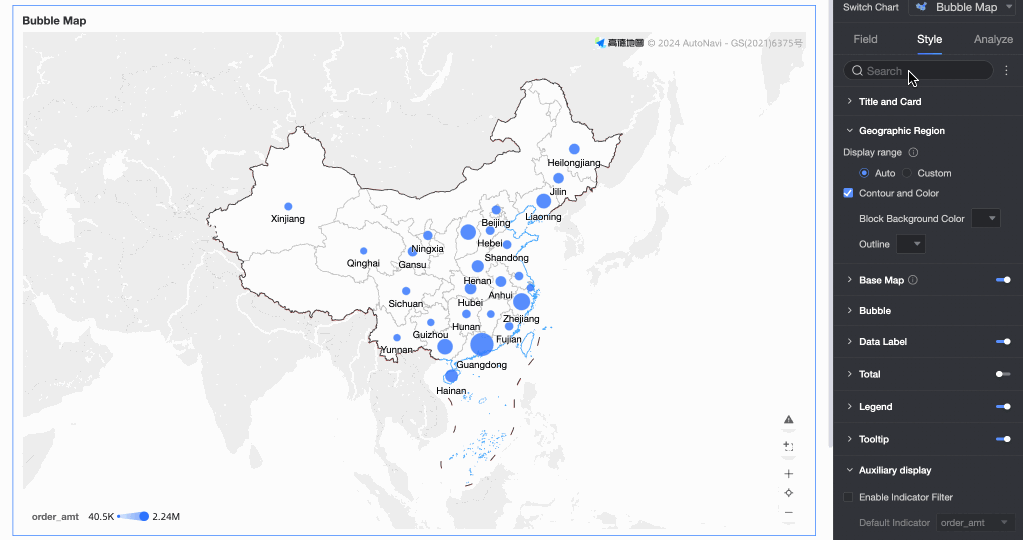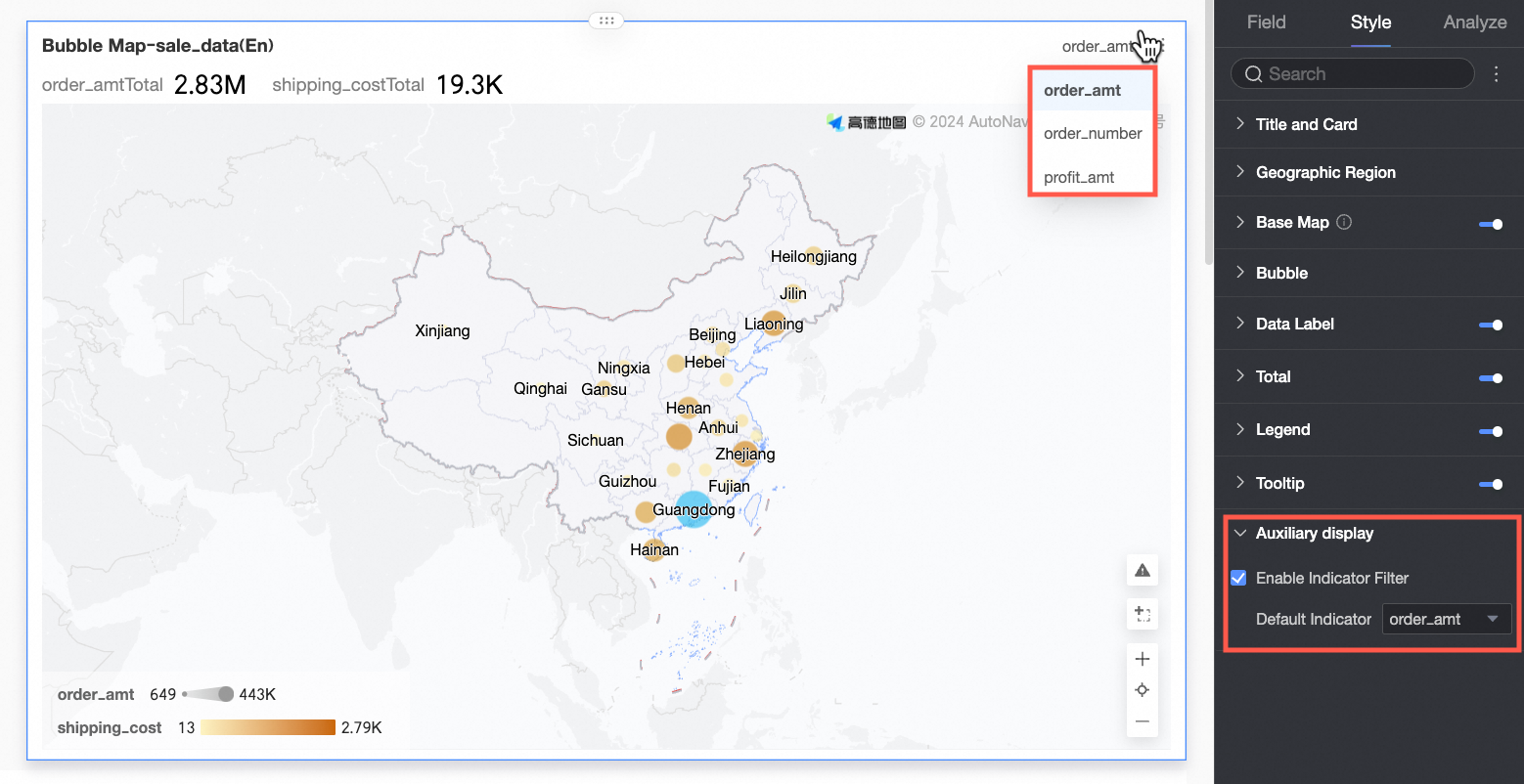A bubble map uses a map as a background and displays bubbles to represent data values. This visualization shows the size and distribution of data measures across different geographic areas. For example, you can use a bubble map to show passenger traffic at tourist attractions or display the per capita income of different regions. This topic describes how to add data to and configure styles for a bubble map.
Prerequisites
A dashboard is created. For more information, see Create a dashboard.
Ensure that the geographic area field to be added is converted to a geographic information type. For more information, see Configure a field.
NoteAssume that the geographic area field to be added to the chart is area. The field is converted to a geographic information type only when the
 icon is displayed. For a detailed mapping of regions, see public-area-info.xlsx. This table is for geographic area mapping only and does not represent the political position of Quick BI.
icon is displayed. For a detailed mapping of regions, see public-area-info.xlsx. This table is for geographic area mapping only and does not represent the political position of Quick BI.
Limits
When you create a bubble map in Area Name mode, the map is configured with the Area Name/Dimension, Bubble Size/Measure, and Bubble Color/Measure fields.
The Area Name field requires a single dimension that contains geographic information, such as a province.
The Bubble Size field requires one to five measures, such as shipping cost and order quantity.
The Bubble Color field requires a single measure, such as the order amount.
When you create a bubble map in Longitude And Latitude mode, the map is configured with the Longitude And Latitude/Dimension, Location Label/Dimension, Bubble Size/Measure, and Bubble Color/Measure fields.
The Longitude And Latitude field requires one longitude dimension and one latitude dimension.
The optional Location Label field requires a string or geographic dimension.
The Bubble Size field requires one to five measures, such as shipping cost and order quantity.
The Bubble Color field requires a single measure, such as order amount.
Overview
Scenarios
You can use bubble maps to show the spatial distribution of data. They are ideal for datasets that contain geographic location information. Bubble maps display aggregated, continuous information for specific regions. The position of each bubble on the map indicates its geographic location, which visualizes the data distribution across different areas.
Advantages
Visualization: Bubble maps support a marker style.
Interactivity: Bubble maps support zooming by area selection, switching measures, and filtering within the widget.
Example

Configure chart fields
On the Fields tab, select the required dimension and measure fields.
Set Geographic Information by selecting either Area Name or Longitude And Latitude.
If you select Area Name, double-click or drag Province to the Area Name/Dimension field.
If you select Longitude And Latitude, double-click or drag the Longitude and Latitude fields to the Longitude And Latitude/Dimension field. The Location Label/Dimension field is optional.
In the Measures list, find and double-click or drag Order Amount to the Bubble Size/Measure field.
In the Measures list, find and double-click or drag Shipping Cost to the Bubble Color/Measure field.
Click Update to automatically update the chart.

Configure chart styles
This section describes the style settings for the chart. For more information about common chart style settings, see Configure the chart title.
In the search box at the top of the configuration section, you can enter a keyword to find a configuration item. You can also click the ![]() icon on the right to expand or collapse all categories.
icon on the right to expand or collapse all categories.

In the Geographic Area section, configure Display Range, Outline And Fill, and Show Base Map.
For Display Range, select Auto or Custom. The options for Custom Range vary based on the selected field. In this example, select China.
NoteThe Auto option automatically adjusts the display based on the data range. The Custom option lets you set the range manually. In interactive analysis scenarios, the display range is always adjusted automatically based on the data.
The custom display range supports global continents and countries, along with regions, provinces, and cities within China.

Turn on Manual Adjustment. The current Centroid and Scaling values are automatically generated, but you can modify them manually.

In the Outline And Fill section, configure the colors for the Area Background and Outline.
NoteOutlines are not available for some areas.

In the Base Map section, configure Show Base Map, Base Map Style, and Show Global Base Map.
Show Base Map: Click the
 switch to show or hide the base map.
switch to show or hide the base map.
Base Map Style: Select from multiple Amap base map styles.

Show Global Base Map: Select this option to display global information, such as cities, on the base map.
 Note
NoteLimits on the global base map: Each Quick BI organization can preview map charts that contain information about regions outside China up to 1,000 times per month. The number of previews is calculated based on the number of times the base map is initialized. If the number of previews exceeds this limit, the map chart displays base map information only for regions within China.
In the Bubble section, set Bubble Color, Max/Min Value Color, Bubble Shape, Bubble Size, and Zero Value Handling.
Bubble Color: Set the theme color, transparency, data mapping range, and number of intervals.

Max/Min Value Color: Configure colors to mark the maximum value, minimum value, top three values, and bottom three values.

Bubble Shape: The available shapes are circle, triangle, rectangle, and diamond.

Bubble Size: Drag the pointer to adjust the bubble size.

Zero Value Handling: The options are Do Not Display, Follow Data Range, and Fixed Bubble Size.

In the Data Label section, configure Show Data Labels, Label Display Mode, and Content, Position, and Text Style.
Show Data Labels:
If you create a map in Area Name mode, you can display both Area Name and Measures.
If you create a map in Longitude And Latitude mode, you can display both Longitude And Latitude and Measures.

Position: The default is Auto. You can select Above Bubble, Below Bubble, or Bubble Center.

Set Label Display Mode to Show All to display the content of all labels.

Text Style: Set the text style for the Area Name, Longitude And Latitude, and Measure data labels.

In the Total section, you can automatically display a summary of the total value of the measures in the chart.

In the Legend section, set the Position and Background Color and Text Style.
Position: The legend can be placed on the Left or at the Bottom.

In the Tooltip section, set whether to Show the tooltip and configure its content, background color, and text style.

In the Auxiliary Display section, you can enable the display of measure filters and set the measure items to display.

Advanced Configuration
Configuration item | Name | Description |
Data Interaction | Drilling | If you have configured drill-down fields on the Fields tab, set the display style for drill-down levels here. For more information, see Drilling. |
Filter Interaction | If the data to be analyzed is in different charts, link the charts to perform data analysis. For more information, see Filter interaction. | |
Jumping | If the data to be analyzed is in multiple dashboards, link them for data analysis. Jumping includes two methods: Parameter Jumping and External Links. For more information, see Jumping. | |
Annotation | - | If data in the chart is abnormal or requires special attention, mark it with color highlights, icons, comments, or data points. This helps identify anomalies and take action.
|